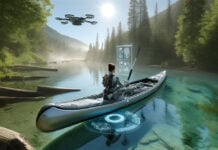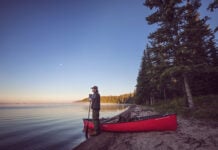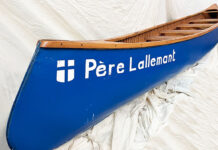This past August, I found myself puddling around the harbor in Prince Rupert, British Columbia. I was on a standup paddleboard painting the hull of a ship called the Polar Prince. And there came on the wind the unmistakeable cough of a de Havilland Canada DHC-2. I could hear it long before I could see it.
As the aircraft taxied away from the wharf and into view in the main harbor I was hit by a tidal wave of nostalgia. Like an old auntie whose means have made possible just about every canoe trip I’d ever been on, that old floatplane—the de Havilland Beaver—is part of my family and an integral part of the lingering lore of a lifetime of wilderness travel.
For a moment, it looked as if the plane was going to run right into our ship. Instead, the pilot, Murray Hamer, shut down the engine and stepped out onto the pontoon and skirled a bag pipe serenade, presumably in recognition of the fact Polar Prince had just nearly completed a circumnavigation of the world’s longest coastline—from Toronto, Ontario to Victoria, B.C. In response to this salute, Jim Pearce, the chief mate of the Polar Prince, himself an accomplished strangler of the three-legged swan, struck his pipes and responded in-kind to the roar of the Beaver pulling away.
Standing there, looking down on my long paddle and lime-green inflatable SUP, then up at the pontoons still dripping as she headed off into the blue, the whole scene made my heart skip a nostalgic beat. I thought of Sir George Simpson, governor of the Hudson’s Bay Company, arriving by canoe at posts from New York to York Factory, Astoria to Alaska with his personal piper playing in time to the swinging of voyageur paddles. I thought of the opening of North America by canoe and how, since World War II, it’s difficult to think about backcountry paddling, trekking, prospecting, hunting… backcountry anything… without simultaneously paying homage to the aircraft which, more than any other, has been responsible for dropping us there.
The cool thing about de Havilland Beavers is they are so much a part of the story of accessing trackless ground all over the world—by the end of production in 1965 there were more than 1,600 Beavers working in 63 countries around the globe—fanatics record their life stories.
A quick Google search reveals the Prince Rupert plane—C-FIAX— was born in Malaysia on July 27, 1951, arriving by sea in crates from Toronto. After a full hitch in the South Pacific, she worked all over Australia for Snowy Mountain Hydro, Aerial Agriculture and Barrier Reef Airlines among other outfits, before being dismantled, repacked and shipped back to Canada. And yet, there she is 68 years later, in the shining colors of Ocean Pacific Air, still lifting people and freight into out-of-the-way places.
On floats, skis and wheels, Beavers have been to the North Pole and the South Pole and almost everywhere in between. The U.S. Army purchased hundreds of Beavers for military assignments, particularly in Korea. Beavers have delivered people and they have rescued people. They have had folding canoes in them. And they have had canoes and ATVs and kitchen tables tied to their pontoons. Even iron clawfoot bathtubs and upright pianos. They have been crashed and they have been rebuilt, re-engined, repurposed and reskinned. And the Beaver has been mythologized by every adventurer whom has ever strapped themselves inside one.
Perhaps the most famous Beaver in the paddling world is Bradley Air Service’s C-FODA. It carried generations of whitewater and wilderness canoeists into the wilds of West Quebec from its base at Rapides des Joachims on the Ottawa River, flown by legendary bush pilot Ronnie Bowes. When it came time to put a Beaver on a new set of millennial edition Canadian coins, in honor of Ronnie’s 21,400 hours in the air—reputed to be the world’s highest time for a Beaver pilot on a single aircraft—a likeness of C-FODA, including its registration, was engraved and minted by the millions for circulation during the final months of 1999.

For anyone who has flown over the threshold of wilderness in a Beaver; for those of us who get all misty-eyed at the very sound of the 450 horsepower, nine-cylinder, air-cooled Pratt and Whitney radial engine, it’s important to acknowledge we passed a family marker date this past summer.
Back on August 16, 1947, the de Havilland Beaver aka DHC-2, was born in Downsview, Ontario, with World War II flying ace, Russell Bannock, at the controls. This summer, my friends, Old Auntie turned 70.
Here’s to the venerable Beaver and to the dedicated characters who fly them, still. Many happy returns.
James Raffan is a regular contributor to Paddling Magazine and the former director of the Canadian Canoe Museum in Peterborough, Ontario. He stepped out of his canoe for five months in 2017 to be the Zodiac driver, bear guard and musical consort to the Arctic icebreaker, Polar Prince. Find more of his articles here.









